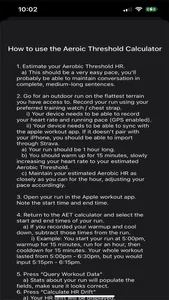Find your Aerobic Threshold heart rate to improve your endurance. Countless studies have shown that the best way to increase your endurance is by training at or below your Aerobic Threshold (AeT). Unfortunately, for a long time the only way to find your AET was an expensive lab test using gas exchange. Recently however, studies have shown that the heart rate drift test can be almost as accurate as a gas exchange test.
The AeT calculator app integrates with Apple Healthkit to allow users to calculate their HR drift without having to export files and upload them to third parties.
How the test works:
1. Estimate your Aerobic Threshold HR.
a) This should be a very easy pace, you’ll probably be able to maintain conversation in complete, medium-long sentences.
2. Go for an outdoor run on the flattest terrain you have access to. Record your run using your preferred training watch / chest strap.
i) Your device needs to be able to record your heart rate and running pace (GPS enabled).
ii) Your device needs to be able to sync with the apple workout app. If it doesn’t pair with your iPhone, you should be able to import through Strava.
a) Your run should be 1 hour long.
b) You should warm up for 15 minutes, slowly increasing your heart rate to your estimated Aerobic Threshold.
c) Maintain your estimated Aerobic HR as closely as you can for the hour, adjusting your pace accordingly.
3. Open your run in the Apple workout app.
Note the start time and end time.
4. Return to the AET calculator and select the start and end times of your run.
a) If you recorded your warmup and cool down, subtract those times from the run.
i) Example: You start your run at 5:00pm, warmup for 15 minutes, run for an hour, then cooldown for 15 minutes. Your whole workout lasted from 5:00pm - 6:30pm, but you would input 5:15pm - 6:15pm.
5. Press “Query Workout Data”
a) Stats about your run will populate the fields, make sure it looks correct.
6. Press “Calculate HR Drift”
a) Your HR drift will be displayed.
6. If your HR drift is between 4.5% - 5.0%, you have successfully found your aerobic heart rate.
a) If it’s under 5%, your heart rate was below your aerobic threshold (running too slow).
b) If it’s over 5%, your heart rate was above your aerobic threshold (running too fast).
You may have to perform the test a few times to get a value of 5.0%
The AeT calculator app integrates with Apple Healthkit to allow users to calculate their HR drift without having to export files and upload them to third parties.
How the test works:
1. Estimate your Aerobic Threshold HR.
a) This should be a very easy pace, you’ll probably be able to maintain conversation in complete, medium-long sentences.
2. Go for an outdoor run on the flattest terrain you have access to. Record your run using your preferred training watch / chest strap.
i) Your device needs to be able to record your heart rate and running pace (GPS enabled).
ii) Your device needs to be able to sync with the apple workout app. If it doesn’t pair with your iPhone, you should be able to import through Strava.
a) Your run should be 1 hour long.
b) You should warm up for 15 minutes, slowly increasing your heart rate to your estimated Aerobic Threshold.
c) Maintain your estimated Aerobic HR as closely as you can for the hour, adjusting your pace accordingly.
3. Open your run in the Apple workout app.
Note the start time and end time.
4. Return to the AET calculator and select the start and end times of your run.
a) If you recorded your warmup and cool down, subtract those times from the run.
i) Example: You start your run at 5:00pm, warmup for 15 minutes, run for an hour, then cooldown for 15 minutes. Your whole workout lasted from 5:00pm - 6:30pm, but you would input 5:15pm - 6:15pm.
5. Press “Query Workout Data”
a) Stats about your run will populate the fields, make sure it looks correct.
6. Press “Calculate HR Drift”
a) Your HR drift will be displayed.
6. If your HR drift is between 4.5% - 5.0%, you have successfully found your aerobic heart rate.
a) If it’s under 5%, your heart rate was below your aerobic threshold (running too slow).
b) If it’s over 5%, your heart rate was above your aerobic threshold (running too fast).
You may have to perform the test a few times to get a value of 5.0%
Show More






